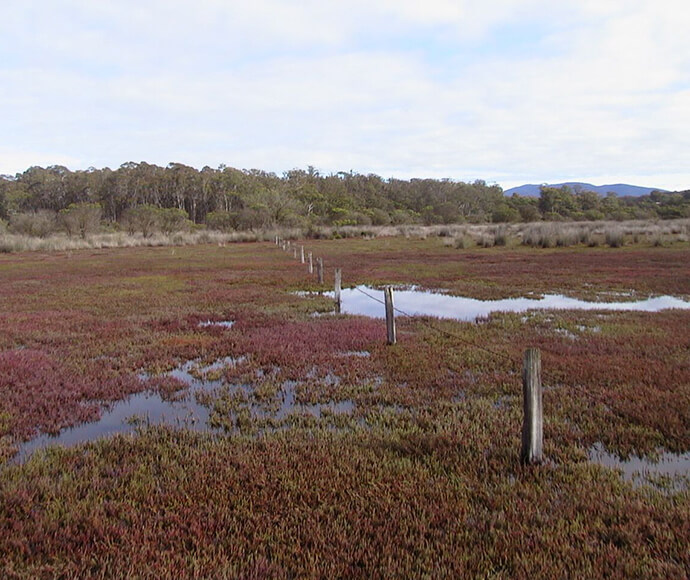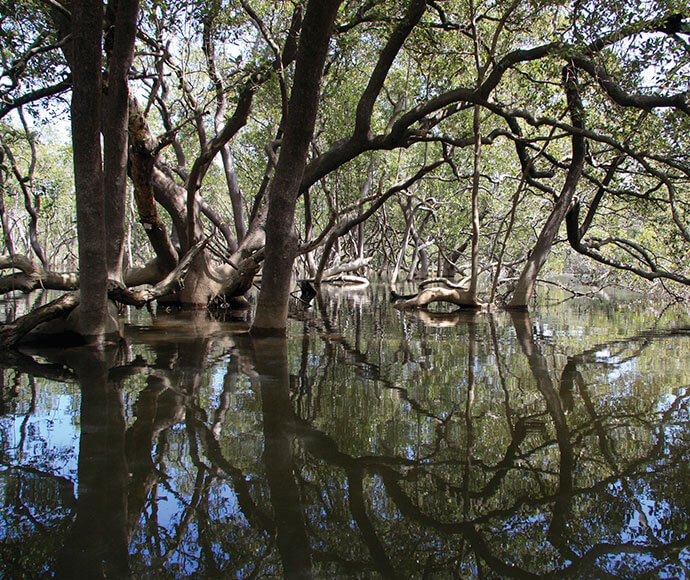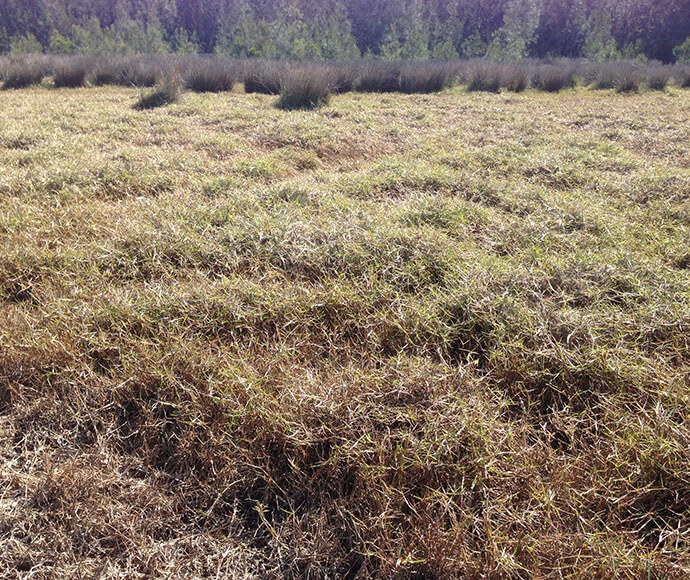Plants that live in estuaries tolerate remarkable environmental stresses, such as changes in water levels or tides, rainfall, currents and salinity. Plants grow in different habitat zones in estuaries, depending on the tides and types of estuaries. For example, salt marsh grows in the intertidal zone between low and high tide, whereas seagrasses grow in shallow water usually near the shore.
Maps of important estuarine habitats in New South Wales such as seagrass, mangroves and saltmarsh are available via our estuaries data portal and the Department of Primary Industries and Regional Development website.
The NSW Department of Primary Industries (DPI) report Mapping the habitats of NSW estuaries (PDF 6.7MB) outlines the importance of estuarine habitats, their location and coverage as well as how these habitats are mapped.

Coastal saltmarsh at Wapengo Lagoon
Seagrasses
Seagrasses are flowering plants that form underwater meadows in subtidal margins of estuaries and shallow, sheltered coastal waters. Six species of seagrass are found in New South Wales. The amount of seagrass growing in estuaries can change over time due to variations in available light, competition from macroalgae, changes in salinity, water clarity and water temperature.
Seagrass meadows are valuable ecosystems because they:
- act as nurseries, many fish spend the juvenile stage of their lifecycle in the protection of seagrass beds
- provide feeding grounds and shelter for diverse species such as prawns, snails, turtles, birds, crabs, dugongs and sea urchins
- reduce the force of current flows, which limits erosion and sediment transport
- act as carbon sinks by storing and burying carbon.
Seagrasses have adapted to living in dynamic environments like estuaries by modifying their roots, water-balance and seed dispersal.
Strapweed (Posidonia australis), the largest of the seagrasses, has declined in some estuaries. It is listed as endangered in Lake Macquarie, Brisbane Waters, Pittwater, Sydney Harbour, Botany Bay and Port Hacking. Eelgrass or ribbon weed (Zostera muelleri) is the most common seagrass in New South Wales.
For more information on seagrasses in our estuaries, see the Seagrasses fact sheet on the NSW Department of Primary Industries and Regional Development website.
Threats
Pollution and suspended sediments negatively impact seagrass by reducing availability of light. Seagrasses are also susceptible to physical damage from:
- dredging activity
- boat moorings
- anchoring
- propeller scars.

Seagrass growing in an estuarine habitat
Mangroves
Mangroves are trees and shrubs that grow in sheltered intertidal areas of estuaries and coastal environments where their roots and lower part of their trunks are periodically inundated by tides.
Six mangrove species occur in New South Wales and grow along the shoreline of about 60% of our estuaries.
Mangroves have adapted to survive in saline or brackish water by having a waxy coating on their leaves to limit the take-up of salt. They also have a unique root system with spiky vertical roots called pneumatophores that draw oxygen into the nutrient-rich oxygen-poor mud of the intertidal zone.
Mangroves are important in estuarine ecology as they:
- provide habitat for juvenile and adult fish, waterbirds, sea turtles, mammals, molluscs and insects
- drop organic matter such as leaves and fruits into estuaries, which provide food for a range of animals
- can form small forests and create a natural breakwater that protects and stabilises the shoreline, prevents erosion and shelters estuaries from storms and strong currents
- improve water quality by filtering run-off from the land
- store carbon and act as a ‘carbon sink’.
Threats
Urban and industrial development in shoreline areas is one of the biggest threats to mangrove habitats. Changes to inundation rates, increases in freshwater flow volumes and velocities, and poor water quality can also significantly impact mangrove habitat.
Climate change is likely to impact mangroves. The potential responses of mangroves to climate change are numerous and will depend on rates of sea level rise and changes in water and sediment quality. For example:
- mangroves may migrate shoreward to avoid permanent inundation and maintain the same tidal range
- permanent inundation of mangroves could cause habitat loss and enhance erosion of shorelines
- the shape of shorelines and the presence of other habitats may prevent mangrove migration
- shoreward migration of mangroves may out-compete of other intertidal habitats like saltmarsh.
For more information on mangroves in our estuaries, see the Mangroves fact sheet on the NSW Department of Primary Industries and Regional Development website.

Mangrove trees in a flooding river
Saltmarsh
Saltmarsh plant communities include a variety of shrubs, sedges, herbs and grasses that tolerate high soil salinity and occasional flooding by seawater. They grow along the upper margin of intertidal areas of estuaries, often on flat areas behind mangroves.
Saltmarshes may or may not be vegetated. Non-vegetated saltmarshes are bare stretches of salty sand or silt called salt pans or salt flats. In some areas, saltmarsh is not inundated by daily tides and relies on king or spring tides to deliver nutrients and exchange water.
Saltmarshes play an important ecological role by:
- filtering sediment and nutrient from land-based runoff, which helps maintain estuarine water quality
- reducing erosion and controlling floods
- storing carbon in plants and sediments, acting as a ‘carbon sink’
- providing food and habitat for fish, prawns, crabs and waterbirds.
Coastal saltmarshes occur in 81% of NSW estuaries and some of these areas are listed as endangered ecological communities.
Threats
Threats to saltmarshes include:
- modified tidal flow
- weed invasion
- damage by domestic and feral animals
- disturbance by human access, including four-wheel drive vehicles and infilling.
Viewed as unsightly or untidy, many saltmarshes have been infilled and now lie buried beneath coastal developments.
There is growing interest in saltmarsh decline due to climate change. Like mangroves, saltmarsh may respond to sea level rise by migrating shoreward to maintain the same tidal range. Rising sea levels may:
- force saltmarsh plant species underwater for longer than they can tolerate and cause them to die
- cause migration of mangroves into areas previously occupied by saltmarsh
- cause increased tidal heights and water velocities that erode and scour habitats, providing opportunity for weeds and mangroves to invade saltmarsh.
The response of saltmarsh to climate change will vary and predicting what will happen is challenging. For more information on saltmarsh in NSW estuaries, see the Coastal saltmarsh fact sheet on the NSW Department of Primary Industries and Regional Development website.
Macroalgae
Macroalgae (often referred to as seaweed) is a group of aquatic plants that occur in brown, red and green forms. The different colours of macroalgae are due to the different pigments they use to convert sunlight into energy through photosynthesis. Macroalgae grows fully submerged in most estuaries in New South Wales and is typically attached to hard substrates like rocks and firm sediment.
Macroalgae comes and goes from estuaries. It responds to nutrient availability, water clarity, water temperature, salinity and water level. Sometimes macroalgae completely take over shallow areas of estuaries for weeks or months at a time, and then disappear following a change like the estuary entrance opening to the ocean or a big rainfall event delivering lots of freshwater or sediment to an estuary.
These plants have basic structures and derive nutrients from surrounding water. They thrive in estuaries that receive abundant nutrients from the surrounding catchment area; therefore, macroalgae can be excellent indicators of an estuary that is nutrient enriched.
Macroalgae is important in estuarine ecology because it can provide habitat and food for juvenile fish and other species, especially when there is no other complex habitat available in that estuary. They can also have direct and indirect impacts on estuaries. For example:
- They can out-compete seagrass for available light, which can lead to the loss and decline of seagrass.
- They can remain in estuaries once they die, sinking to the bottom and decomposing, which releases stored nutrients and depletes the oxygen in the water column, potentially leading to fish kills.
- Decomposing macroalgae washes up on shorelines and can cause nuisance odours and sights for local residents.
Threats
Macroalgae habitats are easily damaged. Loss of macroalgal habitat in estuaries can impact fish diversity and abundance. Physical damage that can directly remove or destroy macroalgae includes:
- boat moorings
- propeller scars
- anchoring
- trampling
- some fishing activities.
Macroalgae can also be indirectly impacted by sedimentation, coastal development and aquaculture. Sea level rise, the intensity and frequency of large storm events, and changes in water quality in response to climate change have the potential to impact macroalgae.
For more information on seaweed and macroalgae in our estuaries, see the Macroalgae fact sheet on the NSW Department of Primary Industries and Regional Development website.
Microalgae
Microalgae are a diverse group of microscopic algae (phytoplankton). They are usually single-celled, and form the basis of many estuarine food webs. Microalgae:
- provide food for filter feeding animals
- provide food for planktonic animals, which include the juvenile life stages of many other animals.
Single-celled algae have the potential for rapid reproduction. When extra nutrients enter estuaries microalgae populations can rapidly increase in size. This response or algal bloom indicates that an estuary has high levels of nutrients and can pose risks to estuaries and people through:
- toxic species causing illness in humans consuming filter feeding animals that have accumulated these toxins
- harmful species causing fish kills
- increasing turbidity, reducing light penetration needed by seagrasses and macroalgae
- increased turbidity reducing visual amenity
- reduction of overnight oxygen levels to lethal levels for aquatic creatures.

Saltmarsh (Zoysia macrantha) at Tomago in the Hunter Wetlands National Park